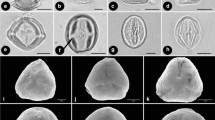Abstract
The acetolysis method intreduced byGunnar Erdtman is still a very welcome and highly successful technique in palynology. However, acetolysis destroys all pollen material with the exception of sporopollenin that forms the outer pollen wall, the exine. Modern palynology in its application to plant systematics and phylogeny must consider all sporoderm characters, not only those of the exine. The neglect of the intine may distort some principal palynological aspects. This is illustrated by cases of total breakdown or gross modification of thin exine structures (e.g. inBeilschmiedia, Strelitzia) and by the clarification of apertures (e.g.,Polyalthia, Fissistigma, Calluna). In our view the investigation of both acetolysed and non-acetolysed pollen is obligatory for a well balanced view of pollen structure and function.
Similar content being viewed by others
References
Albers, F., Pambor, L., 1984: Morphologische Veränderungen von Gras-Pollenkörnern aufgrund verschiedener Behandlungsmethoden. — Pollen & Spores26: 401–408.
Clougher, D., 1986: Pollen wall structure, a new interpretation. — Scanning Electron Micros.1: 291–299.
Erdtman, G., 1954: An introduction to pollen analysis. — Stockholm: Almquist & Wiksell.
—, 1960: The acetolysis method. A revised description. — Svensk Bot. Tidskr.54: 561–564.
—, 1969: Handbook of palynology. Morphology—taxonomy—ecology. — Copenhagen: Munksgaard.
Heslop-Harrison, Y., Heslop-Harrison, J. S., Heslop-Harrison, J., 1986: Germination ofCorylus avellana L. (hazel) pollen: hydration and the function of the oncus. — Acta Bot. Neerl.35: 265–284.
Hesse, M., 1980: Zur Frage der Anheftung des Pollens an blütenbesuchende Insekten mittels Pollenkitt und Viscinfäden. — Pl. Syst. Evol.133: 135–148.
—, 1981: Pollenkitt and viscin threads: their role in cementing pollen grains. — Grana20: 145–152.
—, 1986: Nature, form and function of pollen-connecting threads in angiosperms. — InBlackmore, S., Ferguson, I. K., (Eds.): Pollen and spores, form and function. — Linn. Soc. Symposium Ser.12: 109–118. — London: Academic Press.
—,Waha, M., 1983: The fine structure of the pollen wall inStrelitzia reginae (Musaceae). — Pl. Syst. Evol.141: 285–298.
Morawetz, W., Waha, M., 1985: A new pollen type, C-banded and fluorochrome counterstained chromosomes, and evolution inGuatteria and related genera (Annonaceae). — Pl. Syst. Evol.150: 119–141.
Pacini, E., Juniper, B. E., 1983: The ultrastructure of the formation and development of the amoeboid tapetum inArum italicum Miller. — Protoplasma117: 116–129.
Peter, L. J., 1973: The Peter prescription. — New York: William Morrow.
Reitsma, T., 1969: Size modification of recent pollen grains under different treatments. — Rev. Palaeobot. Palynol.9: 175–202.
Rowley, J. R., Skvarla, J. J., 1987: Ontogeny of pollen inPoinciana (Leguminosae). 2: Microspore and pollen grain periods. — Rev. Palaeobot. Palynol.50: 313–331.
Southworth, D.: Substructural organization of pollen exines. — InBlackmore, S., Ferguson, I. K., (Eds.): Pollen and spores, form and function. — Linn. Soc. Symposium Ser.12: 61–69. — London: Academic Press.
Thanikaimoni, G., 1986: Pollen apertures: form and function. — InBlackmore S., Ferguson I.K., (Eds.): Pollen and spores, form and function. — Linn. Soc. Symposium Ser.12: 119–136. — London: Academic Press.
—,Caratini, C., Nilsson, S., Grafström, E., 1984: OmniaperturateEuphorbiaceae pollen with striate spines. — Bull. Jard. Bot. Nat. Belg.54: 105–125.
Waha, M., Hesse, M., 1988: Aperture types withinSapranthus andPolyalthia (Annonaceae). — Pl. Syst. Evol.161: 135–146.
—,Morawetz, W., 1988: Pollen evolution inAnnonaceae with special reference to the disulcate Australian endemic genera. — Pl. Syst. Evol.161: 1–12.
Wolter, M., Schill, R., 1985: On acetolysis resistant structures in theOrchidaceae—why fossil record of orchid pollen is so rare. — Grana24: 139–143.
Author information
Authors and Affiliations
About this article
Cite this article
Hesse, M., Waha, M. A new look at the acetolysis method. Pl Syst Evol 163, 147–152 (1989). https://doi.org/10.1007/BF00936510
Received:
Issue Date:
DOI: https://doi.org/10.1007/BF00936510




